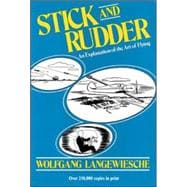
Note: Supplemental materials are not guaranteed with Rental or Used book purchases.
Purchase Benefits
What is included with this book?
Langewiesche set himself the task of describing more accurately and realistically what the pilot really does when he flies.
The first result, from 1940 on, was a series of articles in AIR FACTS, analyzing various points of piloting technique. In 1944 STICK AND RUDDER was published.
Langewiesche has been a test pilot for Cessna, Change Vought, and Kollsman and has also done free-lance testing. He was written on flying, and other matters, in HARPER'S, the SATURDAY EVENING POST, and READER'S DIGEST. He has made long trips over large parts of the world in airplanes of his own.
| PART I WINGS | |||||
|
6 | (19) | |||
|
25 | (20) | |||
|
45 | (11) | |||
|
56 | (23) | |||
| PART II SOME AIR SENSE | |||||
|
79 | (8) | |||
|
87 | (23) | |||
|
110 | (27) | |||
|
137 | (11) | |||
| PART III THE CONTROLS | |||||
|
148 | (15) | |||
|
163 | (13) | |||
|
176 | (14) | |||
| PART IV THE BASIC MANEUVERS | |||||
|
190 | (40) | |||
|
230 | (10) | |||
|
240 | (22) | |||
| PART V GETTING DOWN | |||||
|
262 | (25) | |||
|
287 | (25) | |||
|
312 | (11) | |||
| PART VI THE DANGERS OF THE AIR | |||||
|
|||||
|
323 | (29) | |||
| PART VII SOME MORE AIR SENSE | |||||
|
352 | ||||
|
266 |
The New copy of this book will include any supplemental materials advertised. Please check the title of the book to determine if it should include any access cards, study guides, lab manuals, CDs, etc.
The Used, Rental and eBook copies of this book are not guaranteed to include any supplemental materials. Typically, only the book itself is included. This is true even if the title states it includes any access cards, study guides, lab manuals, CDs, etc.